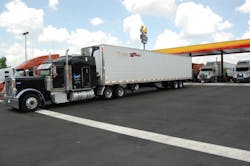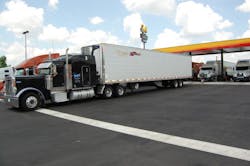There’s also a curious phenomenon in this analysis of “fault lines,” for a challenge that spells trouble in one facet of the freight world – say, the continued labor strife at West Coast ports – can sometimes end up positively affecting another sector.
John Larkin, the managing director for the transportation & logistics research group at Stifel Financial Corp. – formerly known as Stifel, Nicolaus & Co. – boiled down the many different issues examined at FTR’s annual gathering and came up with several “themes” those working in the freight markets should keep in mind:
Theme I: The rate of economic growth remains unimpressive.
With the trend of economic growth equal to the sum of annual population growth (just less than 1%) plus the annualized rate of productivity improvement (slightly more than 1% per annum), annualized economic growth seems to be tracking the trend of around 2%. This remains between a third and one half the normal rate of economic growth following a recession, Larkin noted, with both good and bad portents for the freight world.
“The good news is that this pedestrian rate of growth injects few inflationary pressures into the economy [and] weak growth tends to keep extraordinarily accommodative monetary policy in place, as is evidenced by the Federal Reserve’s recent decision to keep the Fed Funds Rate unchanged yet again,” he said.
Conversely, though, such sluggish growth trend tends to depress the creation of full-time jobs and tends to keep the lid on capital investment, Larkin noted.
“So given the pedestrian rate of economic growth, recent bloating of inventories, the strong U.S. dollar, and the plunge in energy prices, freight volume growth has slowed significantly in 2015,” he stressed. “In addition, fewer supply chain disruptions – such as severe winter weather, horrific intermodal service levels, and pre-stocking of inventories in anticipation of labor-driven west coast port disruptions, etc. – combined with reduced demand have created a more fluid logistics network in 2015, when compared to 2014.
Theme II: The coming onslaught of capacity-sapping federal regulations has changed many shippers’ behavior.
Here’s a theme that offers good tidings for trucking, for in Larkin’s view, large shippers are endeavoring to do more business with their core carriers in anticipation of the coming regulation-driven capacity crisis.
“In addition, large shippers have transitioned freight that previously was tendered to the spot market, over to the contract side of market. So, large shippers are committing more freight to fewer larger, better equipped, better systematized carriers,” he pointed out.
“Shippers are paying higher rates to these core carriers to effectuate this transition,” Larkin added. “As a result, mid-sized and small shippers have been partially hung out to dry by the larger carriers that have tried to be responsive to the large customer’s call for more capacity.”
Yet that’s a pretty good thing for small carriers, as a panel Larkin moderated at FTR’s yearly gig indicated that third part logistics (3PL) providers and freight brokers are “coming to the rescue” by helping smaller and mid-sized customers re-engineer their supply chains while providing more efficient access to scarcer and scarcer capacity.
And that capacity is made up of predominantly small- to mid-sized trucking firms, noted Geoff Turner, president and CEO of Choptank Transport.
“About 92% of motor carriers are made up of six trucks or fewer,” he explained. “They are good, quality carriers and we have access to them. The value we provide is matching that capacity up to specific shipper needs.” That’s certainly a good trucking trend line going forward.
Theme III: The federal regulatory agencies, while well intentioned, struggle to manage their way out of a paper bag.
Larkin basically says out loud what everyone in the freight world is thinking: the Federal Motor Carrier Safety Administration (FMCSA), the Surface Transportation Board (STB), the Department of Transportation as a whole (DOT), even the Pipeline and Hazardous Materials Safety Administration (PHMSA) cannot seem to do their jobs even close to properly.
“None of the rules and regulations coming down the regulatory pipeline at the FMCSA, the STB, or PHMSA seems to be keeping to any reasonable timeline,” Larkin stressed.
“Given that the rules are designed to apply to the broad range of carriers across each mode, there are always some carriers that are hurt worse than others by well meaning, yet often costly to implement, rules and regulations,” he added – with litigation the “weapon of choice” in stalling this regulatory onslaught.
In addition, interim head of the FMCSA, T.F. Scott Darling, III, awaits confirmation hearings in the U.S. Senate, meaning that not much progress on any rule could be made until Darling is confirmed.
Still, all that aside, Annette Sandberg told those gathered at the FTR conference that the Obama administration is likely to try and push as many of its trucking and rail regulations through before the end of its second term in January of 2017.
Theme IV: The logistics industry will struggle to find sufficient numbers of compliant, qualified workers.
As a result, in Larkin’s view, “autonomous trucks cannot come soon enough” for as a “deluge” of forthcoming regulations is eventually implemented, the portion of the nation’s blue collar labor pool serving the transportation and logistics industry is likely to shrink while the productivity of those workers is likely to decrease.
“There appears to be no question that a capacity crisis is coming,” he stressed. “Only the timing remains to be clearly defined. Assuming that the current slow growth economic trajectory is maintained, we think that the capacity crisis could become visible more consistently as we work our way through late 2016 and into 2017.”
Theme V: Domestic intermodal volumes should continue to grow, though partially offset by some international share shift from the West Coast to the East Coast.
Larkin believes the International Longshore and Warehouse Union (ILWU) “may well have shot itself in the foot this time at the west coast ports” as evidence suggests that shippers have pulled market share to the east coast and there is limited evidence of much of that share reverting back.
“Much of the freight imported over east coast ports never sees the railroad as so much of the population in the east lives near the coast,” he explained.
“Domestic freight, on the other hand, is a different story,” Larkin emphasized. “Scarce drivers and expensive tractors can be saved for shorter haul, less-dense lanes – that is, those lanes where intermodal economics break down. Truckers, 3PLs and railroads can collaborate to move an ever increasing percentage of domestic freight moving in the long haul, high density lanes, via rail-based intermodal.”
Thus, the West Coast’s loss might mean an overall gain for trucking. We’ll see how that plays out.

